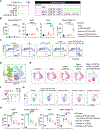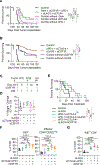Nonredundant Immune Checkpoints Direct Therapeutic Resistance to Chemoimmunotherapy in Pancreatic Ductal Adenocarcinoma
- PMID: 40920092
- PMCID: PMC12560273
- DOI: 10.1158/2326-6066.CIR-25-0575
Nonredundant Immune Checkpoints Direct Therapeutic Resistance to Chemoimmunotherapy in Pancreatic Ductal Adenocarcinoma
Abstract
Pancreatic ductal adenocarcinoma (PDA) is characterized by a myeloid-enriched microenvironment and has shown remarkable resistance to immune checkpoint blockade (e.g., anti-PD-1 and anti-CTLA-4). In this study, we sought to define the role of myeloid immunosuppression in immune resistance in PDA. We report that although depletion of CSF1R+ myeloid cells in combination with anti-PD-1 and chemotherapy triggers T-cell infiltration into PDA, it also causes compensatory remodeling of the myeloid compartment with limited tumor control. Combination therapy against multiple myeloid targets, including CSF1R, CCR2/5, and CXCR2, was insufficient to overcome treatment resistance. High-dimensional single-cell analyses performed on T-cell infiltrates in human and mouse PDA revealed upregulation of multiple immune checkpoint molecules, including PD-1, LAG-3, and CTLA-4. Combinatorial blockade of PD-1, LAG-3, and CTLA-4 along with chemotherapy and anti-CSF1R was necessary to trigger activation of peripheral CD4+ and CD8+ T cells and led to deep, durable, and complete tumor responses, with each immune checkpoint blockade agent contributing to efficacy. Our findings indicate that a comprehensive approach targeting both negative regulatory signals controlling T-cell function and the myeloid compartment will be fundamental to unveiling the potential of immunotherapy in PDA.
©2025 American Association for Cancer Research.
Conflict of interest statement
Conflicts of Interest:
G.L.B. reports prior or active roles as a consultant/advisory board member for Adicet Bio, Aduro Biotech, AstraZeneca, BiolineRx, BioMarin Pharmaceuticals, Boehinger Ingelheim, Bristol-Myers Squibb, Cantargia, Cour Pharmaceuticals, Genmab, HotSpot Therapeutics, Incyte, Janssen, Merck, Molecular Partners, Monopteros, Nano Ghosts, Opsona, Pancreatic Cancer Action Network, Seagen, Shattuck Laboratories, and Verastem; reports receiving commercial research grants from Incyte, Bristol-Myers Squibb, Verastem, Halozyme, Biothera, Hibercell, Newlink, Novartis, Arcus, and Janssen. G.L.B. is an inventor of intellectual property related to CAR T cells managed by the University of Pennsylvania.
Figures




References
-
- Pishvaian MJ, Blais EM, Brody JR, Lyons E, DeArbeloa P, Hendifar A, et al. Overall survival in patients with pancreatic cancer receiving matched therapies following molecular profiling: a retrospective analysis of the Know Your Tumor registry trial. Lancet Oncol 2020;21(4):508–18 doi 10.1016/S1470-2045(20)30074-7. - DOI - PMC - PubMed
-
- Beatty GL, Eghbali S, Kim R. Deploying Immunotherapy in Pancreatic Cancer: Defining Mechanisms of Response and Resistance. Am Soc Clin Oncol Educ Book 2017;37:267–78. - PubMed
MeSH terms
Substances
Grants and funding
LinkOut - more resources
Full Text Sources
Medical
Research Materials
Miscellaneous

